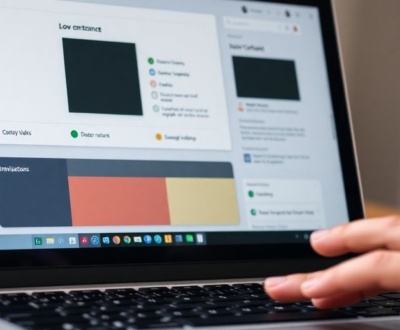So, you’re thinking about building a static site, huh? Maybe you’ve heard they’re fast, secure, and pretty simple to manage. All true! But if you want people to actually find your awesome content through search engines, you need to think about SEO right from the start. It’s not just for big, fancy dynamic websites anymore. Getting your static site design for SEO dialed in can make a huge difference in how many eyeballs land on your pages. We’ll walk through some straightforward ways to make sure your static site gets noticed.
Key Takeaways
- Static sites are great for SEO because they load super fast, which search engines really like.
- Things like good title tags, clear meta descriptions, and easy-to-read URLs are important for any website, including static ones.
- Making sure your static site works well on phones and loads quickly helps a lot with where it shows up in search results.
- Creating useful and interesting content, then putting keywords in naturally, is key to getting found.
- Getting links from other good websites helps your static site look more important to search engines.
Understanding Static Site Design for SEO
Static sites are making a comeback, and for good reason! They’re fast, secure, and surprisingly effective for SEO. Let’s break down what makes them tick and how they can boost your search rankings.
Defining Static Site Generators
Static Site Generators (SSGs) are tools that create static HTML pages from source files, like Markdown or other templating languages. Unlike dynamic sites that generate pages on the fly with each request, static sites serve pre-built files. This means faster loading times and reduced server load. Think of it like baking a cake ahead of time versus baking one every time someone wants a slice. Popular SSGs include Jekyll, Hugo, and Gatsby. They each have their own strengths, but the core principle remains the same: generate static HTML, CSS, and JavaScript files.
Benefits of Static Sites for Search Engine Optimization
Static sites offer several advantages when it comes to SEO:
- Speed: Faster loading times are a major ranking factor. Search engines love fast sites, and so do users.
- Security: With no database or server-side scripting, static sites are less vulnerable to attacks.
- Simplicity: Easier to manage and deploy compared to complex dynamic sites.
- Cost-Effective: Reduced server costs due to lower resource requirements.
Static sites can be a great choice if you prioritize speed and security. They might require a different approach to content management, but the SEO benefits can be significant.
Core Principles of Static Site SEO
SEO for static sites revolves around a few key principles:
- On-Page Optimization: Ensuring each page is properly optimized with relevant keywords, meta descriptions, and title tags.
- Technical SEO: Focusing on site structure, XML sitemaps, and mobile-friendliness.
- Content Strategy: Creating high-quality, engaging content that meets user intent.
- Backlink Building: Earning authoritative backlinks from other websites to boost credibility.
It’s all about making sure search engines can easily crawl and understand your site, and that users have a great experience while they’re there.
On-Page Optimization for Static Sites
On-page optimization is super important for static sites. Since you don’t have a database-driven CMS doing a lot of the work for you, you need to be extra careful about getting the basics right. It’s all about making sure search engines can easily understand what your site is about and that users have a good experience.
Crafting Effective Title Tags and Meta Descriptions
Title tags and meta descriptions are your first chance to make a good impression in search results. Think of them as the ad copy for your website. Your title tag should be concise, include your primary keyword, and accurately reflect the page’s content. Meta descriptions should expand on the title, enticing users to click. Keep them within the recommended length (around 160 characters for meta descriptions) so they don’t get cut off in search results. It’s a bit of an art, but well worth the effort.
Optimizing Content with Relevant Keywords
Keywords are still important, but keyword stuffing is a big no-no. Focus on creating high-quality, relevant content that naturally incorporates the terms your audience is searching for. Use keywords in headings, subheadings, and throughout the body of your text, but make sure it reads naturally. Think about what questions your target audience is asking and answer them thoroughly.
Don’t just write for search engines; write for people. If your content is helpful and engaging, search engines will reward you.
Structuring URLs for Improved Readability
Your URLs should be clean, concise, and descriptive. Avoid using long strings of numbers or special characters. Instead, use keywords that accurately reflect the page’s content. For example, instead of example.com/page?id=123, aim for something like example.com/static-site-seo. This not only helps search engines understand the page’s topic but also makes it easier for users to share and remember your links.
Here’s a quick comparison:
| URL Type | Example | Readability | SEO Friendliness |
|---|---|---|---|
| Unoptimized | example.com/page?id=123 |
Low | Low |
| Keyword-Rich & Concise | example.com/static-site-seo |
High | High |
| Long & Complicated | example.com/blog/category/article-12345 |
Medium | Medium |
Technical SEO Considerations for Static Sites
Static sites, while offering numerous advantages, require a specific approach to technical SEO. It’s not as simple as slapping up some content and hoping for the best. You need to think about how search engines crawl and index your site. Let’s get into the nitty-gritty.
Enhancing Page Speed and Performance
Page speed is a critical ranking factor. Static sites should be fast, but that doesn’t mean you can ignore optimization. Here’s what to keep in mind:
- Optimize images: Use appropriate formats (WebP, AVIF), compress them, and use responsive images.
- Minify code: Remove unnecessary characters from HTML, CSS, and JavaScript files.
- Leverage browser caching: Set appropriate cache headers to reduce server load and improve load times for returning visitors.
A slow website can kill your SEO efforts before they even begin. Make sure you’re using tools like Google PageSpeed Insights to identify and fix performance bottlenecks.
Ensuring Mobile Responsiveness Across Devices
Mobile-first indexing is the standard now. If your site isn’t mobile-friendly, you’re in trouble. Here’s what to do:
- Use a responsive design framework: Ensure your site adapts to different screen sizes.
- Test on multiple devices: Don’t just assume it looks good; actually check it on various phones and tablets.
- Optimize for touch: Make sure buttons and links are easy to tap on mobile devices.
Implementing XML Sitemaps for Indexing
An XML sitemap helps search engines discover and index your site’s content more efficiently. It’s like giving them a roadmap. Here’s how to do it:
- Create an XML sitemap: Use a tool or script to generate a sitemap that lists all your important pages.
- Submit it to search engines: Submit your sitemap to Google Search Console and Bing Webmaster Tools.
- Keep it updated: Automatically update your sitemap whenever you add or remove pages. For static sites, you can use tools to automate dynamic sitemaps generation.
Here’s an example of what a basic sitemap might look like:
<?xml version="1.0" encoding="UTF-8"?>
<urlset xmlns="http://www.sitemaps.org/schemas/sitemap/0.9">
<url>
<loc>https://www.example.com/</loc>
<lastmod>2025-06-30</lastmod>
<changefreq>monthly</changefreq>
<priority>1.0</priority>
</url>
<url>
<loc>https://www.example.com/about</loc>
<lastmod>2025-06-29</lastmod>
<changefreq>monthly</changefreq>
<priority>0.8</priority>
</url>
</urlset>
Content Strategy for Static Site SEO

Content is king, they say. And it’s true, especially when you’re dealing with static sites. You don’t have a fancy database-driven CMS to rely on, so what you do publish needs to be top-notch. It’s got to be good enough to attract visitors and keep them around. Let’s talk about how to make that happen.
Developing High-Quality, Relevant Content
The cornerstone of any successful SEO strategy is high-quality content. It’s not just about throwing keywords onto a page; it’s about creating something that people actually want to read, watch, or listen to. Think about what your audience is searching for and then deliver it in a way that’s engaging and informative.
Here’s a few things to keep in mind:
- Know your audience: Who are you trying to reach? What are their pain points?
- Solve problems: Provide solutions to their questions and challenges.
- Be original: Don’t just rehash what everyone else is saying. Bring a fresh perspective.
Integrating Keywords Naturally within Content
Okay, so you’ve got great content. Now, how do you make sure search engines know what it’s about? That’s where keywords come in. But, and this is a big but, you can’t just stuff them in willy-nilly. It has to feel natural.
Here’s how I usually approach it:
- Research: Use tools to find relevant keywords with decent search volume.
- Prioritize: Focus on a primary keyword for each page or post.
- Incorporate: Use the keyword in the title, headings, and throughout the body of the content, but don’t overdo it.
Leveraging Headings for Content Organization
Headings aren’t just for making your content look pretty. They’re also a powerful SEO tool. They help search engines understand the structure and hierarchy of your content. Plus, they make it easier for readers to scan and find what they’re looking for.
Think of headings as signposts for both search engines and users. Use them strategically to guide people through your content and highlight key information.
Here’s a quick guide:
- H1: Use only one H1 per page, and make it the main title.
- H2: Use H2s for major sections.
- H3-H6: Use these for subsections and supporting points.
And remember, include relevant keywords in your headings where it makes sense. It’s all about balance!
Building Authority Through Backlinks
Backlinks are like votes of confidence from other websites. They tell search engines that your site is a credible source of information. Building authority through backlinks is a long-term game, but it’s one of the most effective ways to improve your static site’s search engine rankings. Focus on earning backlinks from reputable and relevant websites in your industry. It’s better to have a few high-quality backlinks than a ton of low-quality ones.
Identifying Link Building Opportunities
Finding the right link building opportunities is key. Start by analyzing your competitors’ backlink profiles to see where they’re getting their links. Look for opportunities to get listed in industry directories, participate in relevant forums, and create content that other websites will want to link to. Don’t be afraid to reach out to other website owners and bloggers to ask for backlinks, but make sure you have something valuable to offer them in return. You can also use tools to find broken links on other sites and offer your content as a replacement. This is a great way to build backlinks and help other website owners at the same time.
Strategies for Acquiring Quality Backlinks
There are several strategies you can use to acquire quality backlinks. Here are a few ideas:
- Guest Posting: Write articles for other websites in your niche and include a link back to your site in your author bio or within the content.
- Creating Linkable Assets: Develop high-quality content, such as infographics, ebooks, or original research, that other websites will want to link to.
- Broken Link Building: Find broken links on other websites and offer your content as a replacement.
- Resource Page Link Building: Identify resource pages in your niche and ask to have your site added to the list.
Remember, building backlinks takes time and effort. Don’t expect to see results overnight. Focus on creating valuable content and building relationships with other website owners, and the backlinks will come naturally.
Promoting Content for Increased Visibility
Creating great content is only half the battle. You also need to promote it to get it in front of the right people. Share your content on social media, email it to your subscribers, and reach out to influencers in your niche. The more people who see your content, the more likely it is that they’ll link to it. Consider running targeted ads to promote your content to a wider audience. Also, make sure your site has a clear call to action, so people know what you want them to do after reading your content.
Advanced SEO Techniques for Static Sites

Static sites, while simple, can still benefit from advanced SEO strategies. It’s not just about the basics anymore; we need to think outside the box to really compete. Let’s explore some techniques to give your static site an edge.
Automating SEO Templates for Efficiency
One of the biggest challenges with static sites is managing SEO elements across many pages. Automating SEO templates can save a ton of time and ensure consistency. Instead of manually adding titles and meta descriptions to each page, you can create templates that dynamically generate these elements based on page content. This is especially useful as your site grows. Think of it as setting up a system that handles the repetitive tasks, freeing you up to focus on strategy and content.
Generating Dynamic Sitemaps for New Pages
Sitemaps are essential for helping search engines crawl and index your site. With static sites, manually updating the sitemap every time you add a new page can be a pain. Automating sitemap generation ensures that your sitemap is always up-to-date. This is particularly important if you’re frequently adding new content. There are tools and scripts available that can automatically generate a sitemap whenever you build or deploy your site. This keeps search engines informed about your latest content, improving your chances of getting indexed quickly.
Verifying Source Code for Optimal Performance
Even with static sites, the final HTML source code can sometimes contain unexpected issues that affect SEO. It’s a good idea to verify the source code after your site is generated. This helps you catch any errors, inconsistencies, or unnecessary code that could be slowing down your site or affecting its ranking. Look for things like broken links, missing alt tags, or incorrect schema markup. Tools like Google’s PageSpeed Insights can help you identify areas for improvement.
Regularly checking your source code ensures that your site is performing at its best and that search engines can properly understand and index your content.
Here are some things to check:
- Valid HTML
- Proper use of semantic tags
- Correct schema markup
- Optimized image sizes
Measuring and Adapting Static Site SEO
It’s not enough to just build a static site and hope for the best. You need to keep an eye on how it’s performing and make changes as needed. Think of it like tending a garden – you can’t just plant the seeds and walk away. You have to water, weed, and prune to get the best results. SEO is the same way. Regular monitoring and adjustments are key to maintaining and improving your site’s visibility in search results.
Monitoring Search Engine Rankings
Keeping track of where your site ranks for important keywords is super important. There are a bunch of tools out there that can help you do this, from free options like Google Search Console to paid services that offer more in-depth analysis.
Here’s what you should be looking at:
- Keyword rankings: Are your target keywords moving up or down in the search results?
- Overall traffic: Is your organic traffic increasing or decreasing?
- Indexed pages: Is Google indexing all of your important pages?
Analyzing User Behavior and Engagement
It’s not just about getting people to your site; it’s about what they do once they get there. Are they sticking around and reading your content, or are they bouncing right away? Google Analytics is your friend here. It can give you a ton of info about how users are interacting with your site.
Key metrics to watch:
- Bounce rate: The percentage of visitors who leave after viewing only one page.
- Time on page: How long users are spending on each page.
- Pages per session: The average number of pages a user views during a session.
- Conversion rate: If you have specific goals (like signing up for a newsletter or making a purchase), track how often users are completing those actions.
Adjusting Strategies Based on Performance Data
Okay, you’ve got all this data. Now what? It’s time to put it to use. If you’re seeing that certain keywords aren’t performing well, you might need to tweak your content or target different keywords altogether. If your bounce rate is high, you might need to improve your site’s design or make your content more engaging.
Don’t be afraid to experiment. SEO is an ongoing process, and what works today might not work tomorrow. Keep testing new strategies and tracking your results to see what works best for your site.
Here’s a simple example of how you might adjust your strategy based on performance data:
| Metric | Current Performance | Potential Adjustment |
|---|---|---|
| Keyword Ranking | Low | Revise content, build more backlinks to the page |
| Bounce Rate | High | Improve page design, make content more readable |
| Conversion Rate | Low | Optimize call-to-actions, improve user experience |
Conclusion
So, there you have it. Getting your static site to show up well in search results isn’t some kind of magic trick. It’s really about paying attention to the basics: good content, making sure your site loads fast, and setting things up so search engines can easily figure out what your site is all about. It might seem like a lot at first, but once you get these things dialed in, you’ll be in a good spot. Just keep at it, and your static site will be doing great in no time.
Frequently Asked Questions
Can a basic static site really do well with SEO?
Yes, you can absolutely get good search engine optimization (SEO) with a simple static site. While more complex websites might have fancy tools, a well-built static site can still rank high. The key is to make sure your content is great, your site loads super fast, and it works well on phones and tablets.
What are the most important steps to make my static site good for search engines?
To make your static site SEO-friendly, focus on a few things. First, make your page titles and descriptions clear and catchy. Second, use keywords naturally in your writing. Third, make sure your website loads quickly. Fourth, design it so it looks good on any device, like a phone or a computer. Lastly, make sure your website’s addresses (URLs) are easy to read.
How important is website speed for SEO on a static site?
Speed matters a lot for SEO. When your site loads fast, people are more likely to stay and look around, and search engines like Google notice that. Slow sites can make people leave, which tells search engines your site might not be that good. So, making your site quick helps both your visitors and your search ranking.
Does my static site need to look good on phones for SEO?
Mobile-friendliness is super important. Most people use their phones to browse the internet these days. If your static site doesn’t look right on a phone, people will quickly leave. Search engines also prefer websites that work well on all devices, so making your site mobile-friendly can boost your ranking.
What is an XML sitemap and why do I need one for my static site?
An XML sitemap is like a map for search engines. It tells them about all the pages on your website and how they’re connected. This helps search engines find and understand all your content, making it easier for them to show your site in search results. It’s a simple but powerful tool for static sites.
How can I get other websites to link to my static site?
Even though static sites don’t have built-in ways to get links, you can still earn them. The best way is to create really good content that others want to share or link to. You can also reach out to other websites in your area and offer to write a guest post or team up on something. Quality links from other sites tell search engines that your site is trustworthy and important.
About this blog
We are a digital marketing company with a focus on helping our customers achieve great results across several key areas.
Request a free quote
We offer professional SEO services that help websites increase their organic search score drastically in order to compete for the highest rankings even when it comes to highly competitive keywords.









